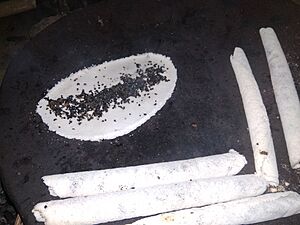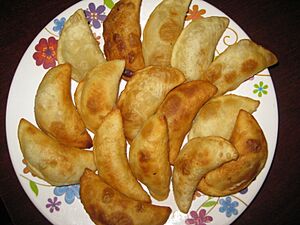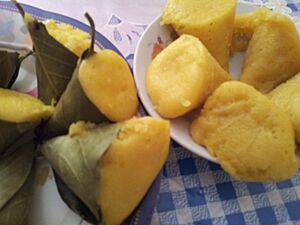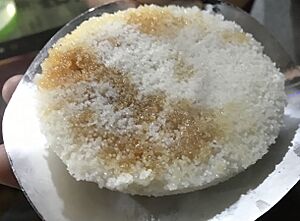Pitha facts for kids

Various pithas on display at Chittagong, Bangladesh
|
|
| Course | Whole meal, snack or dessert |
|---|---|
| Place of origin | Assam, Odisha, Jharkhand, Bengal region, Bihar and Eastern Uttar Pradesh |
| Associated national cuisine | Assamese cuisine, Odia cuisine, Jharkhandi cuisine, Bengali cuisine and Bhojpuri cuisine |
| Main ingredients | Rice flour or wheat flour |
Pithas are a type of food from the Indian subcontinent, popular in Bangladesh and India. They are like pancakes, dumplings, or fritters. Pithas can be sweet or savory. They are usually made from a dough or batter. This dough is then steamed, fried, or cooked on a griddle.
Most pithas are not baked in an oven or boiled. They are often cooked on a stovetop. Some pithas have a yummy filling inside. Others might have a special topping or sauce. People usually eat pithas as a snack with chai. They are also popular treats during special events and holidays.
Pitha is very popular in Bangladesh. It is also loved in eastern Indian states like Bihar, Uttar Pradesh (eastern parts), West Bengal, Odisha, and Jharkhand. You can also find them in Kerala in South India and in Northeast India, especially Assam. Pithas are mostly made from rice flour. But some types use wheat flour. Less common pithas are made from palm or a local root vegetable called ol.
Contents
How to Make Pitha
Pithas are mainly made from a batter of rice flour or wheat flour. This batter is shaped and can be filled with sweet or savory ingredients. When a pitha is filled, the pocket holding the filling is called a khol. The fillings inside are called pur.
For savory pithas, ingredients like cauliflower, cabbage, radish, or potato are often used. These vegetables are usually fried, baked, or steamed. Then they are mashed, cooled, and shaped into small balls. These balls are then used to stuff the pithas.
Sweet pithas often contain sugar, jaggery, date juice, or palm syrup. They can be filled with grated coconut, fried sesame seeds, cashews, or pistachios. Sweetened vegetables or fruits can also be used. Sweet pithas are often flavored with cardamom or camphor.
Pithas can be cooked in different ways. They can be fried in oil or ghee. Some are slow-roasted over a fire. Others are steamed or baked on a hot plate. Pithas are often eaten for breakfast or as a snack with tea. Many sweet varieties are saved for desserts or holidays.
Pithas from Different Regions
Pithas are made differently across the eastern Indian subcontinent. Each region has its own special types.
Pithas in Assam
In Assam, pitha is a special rice dish. It is usually made only for special events like Bihu. Assamese pithas are often made from bora saul, which is a special glutinous rice. They can also be made from xaali saul or sun-dried rice.
Here are some common Assamese pithas:
- Kachi pitha (meaning "Sickle pitha"): This is a pan-baked pancake. It is made from bora saul. It is filled with sesame seeds, ground coconut, dried orange rind, and jaggery.
- Ghila pitha (meaning "knee pitha"): This is a fried pitha. It is made from bora saul and jaggery. A savory version can be made with salt instead of jaggery.
- Sunga pitha: This special pitha uses both xaali saul and bora saul. They are mixed with water and jaggery. The mixture is put into a young bamboo tube. The tube is sealed with a banana leaf and roasted in fire. The cooked cake is then cut and served with hot milk.
- Tekeli pitha (meaning "earthenware pitha"): This pitha also uses xaali saul and bora saul. It is mixed with coconut, sugar, and powdered milk. Cardamom and dried orange rind can be added. This pitha is steamed in an earthenware pot or a kettle.
- Til pitha: This pitha is made with sesame and rice. Rice flour is spread in a circle on a hot pan. Roasted sesame seeds are placed in the circle with sugar or jaggery. Then it is rolled into a cylindrical shape.
Pithas in Bangladesh, West Bengal, and Tripura
Some pithas can be made all year in Bengal (which includes Bangladesh and the Indian states of West Bengal, Tripura, and others). But some special pithas are linked to harvest festivals. These include Nabanna (meaning "new rice") and Poush parbon or Makar Sankranti. These festivals are celebrated in autumn and winter. During these seasons, pitha mela or pitha utshob (pitha festivals) are held in Bangladesh.
Common ingredients for pithas in Bengal include rice flour, milk, coconut, and jaggery. Pithas are often served with sweet syrups. A popular one is date tree molasses.
Here are a few common pithas found in Bengal:
- Teler piṭha (meaning "oil pitha"): This pitha is fried in oil. It is also known as Guror Handesh. It started in Sylhet, Bangladesh.
- Khola chitoi: This is a crêpe made with rice flour and eggs. It comes from Noakhali.
- Nuner pitha (meaning "The pitha of salt"): This pitha is made from water, onions, gingers, turmeric powder, Salt, Coriander leaves, chilli pepper, and rice flour. The mixture becomes a dough, which is flattened and cut into circles. It started in Sylhet.
- Puli piṭha: This is a dumpling-like dish. It has braided edges and is stuffed with a coconut mixture or kheer. It can be fried or steamed.
- Nakshi Pitha (meaning "The Pitha of artistic patterns"): This pitha is a special dough sculpted into art. It uses a bamboo stick or a small metal plate. This beautiful pitha comes from rural Bangladesh.
- Paṭi shapta: These are thin crepes. They are stuffed with jaggery and coconut or kheer.
- Bhapa Pitha/Dhupi pitha: This is a steamed ricecake.
- Taler pitha (meaning "palm pitha"): This pitha is always made with Asian palmyra palm fruits. It can be fried, steamed, or made with batter. There are many types of Taler Pitha.
- Bibi khan Pitha: This is a steamed pitha that looks like a cake. It started in the Bikrampur district, Dhaka, Bangladesh.
- Aske Pitha/Chitoi Pitha: This is a pancake-like dish made with batter. You need a special pan to make it. Chitoi Pitha is often eaten with spicy bhortas (mashed dishes).
There are many different pithas in every region of Bengal. These are just a few examples.
Pithas in Bhojpuri Region
In the Bhojpuri region, there is a tradition of making Pitha for the Godhan occasion. It is made with rice and pulses that are soaked and then ground.
Images for kids
























